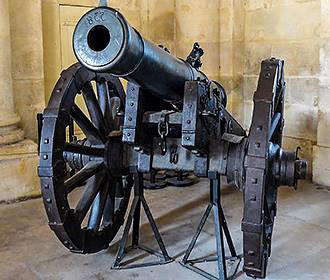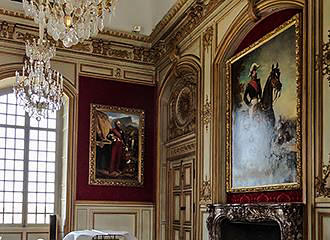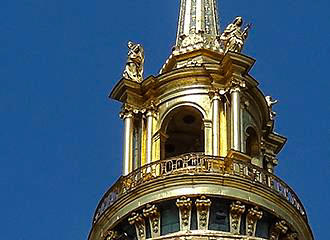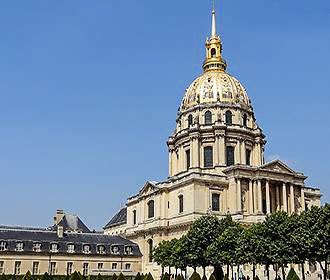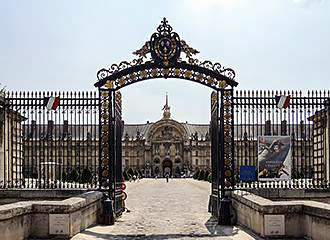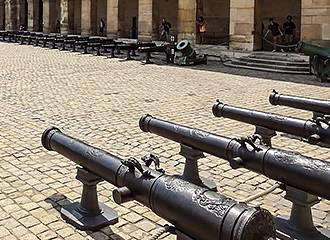Paris Les Invalides history and historical events
With the official name of the Hotel National des Invalides, this is a fascinating place to visit whilst you are on holiday in Paris, and its not just the grand Paris Les Invalides history you can enjoy, there are lots of different sections and Paris museums all combined within the one place, including the Tomb of Napoleon I.
However, lets take a look at Les Invalides history
There was not a single institution that existed that was able to accommodate disabled solders and war veterans up until the reign of King Louis XIV. So, Paris Les Invalides history started way back in 1670, when King Louis XIV decided to create a care home for those that had either been injured whilst fighting for France or for those that were too old to still fight, and hence the name of Hotel National des Invalides.
The project was placed in the hands of the War Minister and Secretary of State Louvois, who had a full name of Francois Michel Le Tellier, Marquis de Louvois, normally referred to as just Louvois. The other person entrusted with the work was a trusted architect, Liberal Bruant, who also lived in Paris and these people were to come up with the design of Les Invalides and oversee construction, which was actually completed in under four years.
The Les Invalides North facade with its central entrance pavilion is in a very typical and classical French style of Liberal Bruant who was from a family of architects and he enlisted the help of respected sculptor Guillaume Coustou for the statues and reliefs etc, while the roofs were decorated with fire pots and skylights with war trophies, with every decoration, even as an allegory, being to the glory of King Louis XIV.
Although, when you are in the central courtyard of Les Invalides called the Cour d'Honneur, you will see one particular skylight that differs from all others, as this has a wolf head and other features that represent the coat of arms of Louvois, who would never have been allowed his own emblems on this building, so hence this particular skylight is known as the Lucarne de Louvois.
Les Invalides history first residents
So the first residents at Hotel National des Invalides were settling in to their new surroundings in the building as early as the October of 1674, and by the end of the 17th century the 4000 or so residents were ruled in the same way as monasteries and barracks, with the soldiers being divided into companies where they were set tasks in workshops. But the severely injured were taken care of in the hospital section, which was located in the South East section of Les Invalides and this hospital is still active today.
The Hotel National des Invalides building work did not stop there however, and construction began on a church with the specification that the King and soldiers could all hear mass at the same time but through protocol and decorum there would be two separate entrances.
But after the construction of the church was never completed, in 1676 the Minister of War collaborated with Jules Hardouin Mansart and instructed him to take over, after this renowned architect came up with a brilliant idea and a solution to the decorum problem. So the church got divided into two with one being the Eglise des Soldats, purely the soldiers church and the other being the Eglise du Dome, or dome church and the royal church.
And with its classical architecture and harmonious manner the Eglise des Soldats was completed in 1679, but the organ case took from 1679 through to 1687 to be made by the king carpenter, Germain Pilon and was painstakingly restored between 1955 and 1957.
The vault itself is decorated with flags and trophies that were taken from the enemies, although the trophies were originally hung from the vault at the Notre Dame Cathedral until the French revolution and those that survived were transferred to Les Invalides in 1793.
Today at Hotel National des Invalides, you can see over a hundred exhibits of trophies from the enemies, that are positioned on the cornice of the church, and show the military history of France from 1805 up until the 20th century.
The Les Invalides church today is devoted to Saint Louis and the Holy Trinity and it is now classed as the French armies cathedral which has been run by the Musee de l’Armee since 1905, and every year there are commemorative masses held here such as the Anniversary mass for the founding of the Hotel National des Invalides and another for the death of Napoleon Bonaparte.
Les Invalides history the soldiers church
The Soldiers Church, is now referred to as the Saint-Louis Cathedral and as well as still performing mass and other religious services, this is also a place where people can come enjoy concerts with a full program organised by the Musee de l'Armee for various type of music concerts conducted throughout each year.
But getting back to the Les Invalides history and the church. The construction of the whole church including the royal chapel, known as the Eglise du Dome, was started in 1677, yet not completed until 1706 and the interior represents the glory of King Louis XIV, the Monarchy and its armies.
Again, the Eglise du Dome was completed under the direction of Jules Hardouin-Mansart, who was the incredible French architect and genius that also completed the design of many aspects of the Chateau de Versailles such as the Grand Trianon, which is located on the outskirts of Paris in the Ile de France region and probably the most famous of all former royal castles in France.
The Hotel National des Invalides golden dome itself is topped with a lantern that measures 101m in height, and in 1989 this dome went under major renovations with the mammoth task of re-gilding that ended up utilising 12kg of gold also restoring the paintings on the cupola, or underside, of the dome as well!
Now over the years, Les Invalides expanded and included a hospice, barracks, a hospital and workshops and by the 18th century it housed up to 4,000 residents with it being under the control of the Consulate, then this went to the Empire with Napoleon Bonaparte being the patron of the Hotel National des Invalides.
Les Invalides history of Eglise du Dome
Napoleon I actually restructured the institution and then began transforming the Saint Louis church and the Eglise du Dome part of Les Invalides into a national military pantheon with the tombs of Turenne and Vauben buried here.
After Napoleon I died, his body was eventually brought back to Paris, and at first the thought was for a burial at the Pantheon, yet after discussions Les Invalides was decided upon within the Eglise du Dome that he had been a patron of, and so, with the funeral procession travelling by the Arc de Triomphe that he had originally commissioned, he was taken to the Hotel National des Invalides. Yet after 20 years of modifying the interior of the Eglise du Dome including excavation and erecting the crypt, the task was completed.
A marble statue of Napoleon Bonaparte was sculpted by Pierre-Charles Simart to be placed within the crypt of the Eglise du Dome and there are also 12 statues representing the military campaigns of Napoleon Bonaparte that were commissioned to the sculptor James Pradier who had previously worked on statues and sculptures for places such as at the Place de la Concorde and the Palais du Luxembourg to name a few.
There are also the bodies of Napoleon's son, his brothers, generals and marshals that are also buried here today along with Napoleon Bonaparte's tomb as well, which is all part of the museum visit you can enjoy today, not forgetting the other museums and armaments such as a tank and canons on display within the Hotel National des Invalides historical complex that also still operates as was originally intended.
